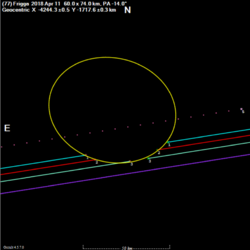Astronomy:77 Frigga
| Discovery | |
|---|---|
| Discovered by | Christian Heinrich Friedrich Peters |
| Discovery date | November 12, 1862 |
| Designations | |
| (77) Frigga | |
| Pronunciation | /ˈfrɪɡə/[1] |
| Named after | Frigg |
| Minor planet category | Main belt |
| Orbital characteristics | |
| Epoch December 31, 2006 (JD 2454100.5) | |
| |{{{apsis}}}|helion}} | 452.196 Gm (3.023 AU) |
| |{{{apsis}}}|helion}} | 346.228 Gm (2.314 AU) |
| 399.212 Gm (2.669 AU) | |
| Eccentricity | 0.133 |
| Orbital period | 1592.266 d (4.36 a) |
| Average Orbital speed | 18.15 km/s |
| Mean anomaly | 346.682° |
| Inclination | 2.433° |
| Longitude of ascending node | 1.332° |
| 61.419° | |
| Physical characteristics | |
| Dimensions | 69.2 km[2] |
| Mass | (1.74 ± 0.68) × 1018 kg[3] |
| Mean density | 11.05 ± 4.34[3] g/cm3 |
Equatorial surface gravity | 0.0193 m/s² |
Equatorial escape velocity | 0.0366 km/s |
| Rotation period | 9.0 hr[2] |
| Geometric albedo | 0.144[2][4] |
| M | |
| Absolute magnitude (H) | 8.52[2] |
Frigga (minor planet designation: 77 Frigga) is a large, M-type, possibly metallic main-belt asteroid. It was discovered by the German-American astronomer C. H. F. Peters on November 12, 1862. The object is named after Frigg, the Norse goddess. The asteroid is orbiting the Sun with a period of 4.36 years and completes a rotation on its axis every nine hours.
Frigga has been studied by radar.[5] The spectra of this asteroid displays a feature at a wavelength of 3 μm, indicating the presence of hydrated minerals on the surface.[6] The near infrared spectrum is reddish and shows no spectral absorption features. Potential analogs of this spectrum include enstatite chondrites and nickel-iron meteorites.[7]
Since 1999 there have been four stellar occultations by the asteroid. The first three were single chord observations, and the fourth was a 3-chord observation, and a miss. The best fit ellipse measures 60.0x74.0 kilometres at PA -14degrees.[8]
References
- ↑ Template:Cite RDPCE
- ↑ 2.0 2.1 2.2 2.3 "JPL Small-Body Database Browser: 77 Frigga". Jet Propulsion Laboratory. https://ssd.jpl.nasa.gov/sbdb.cgi?sstr=77.
- ↑ 3.0 3.1 Carry, B. (December 2012), "Density of asteroids", Planetary and Space Science 73: pp. 98–118, doi:10.1016/j.pss.2012.03.009, Bibcode: 2012P&SS...73...98C. See Table 1.
- ↑ Asteroid Data Sets
- ↑ "Radar-Detected Asteroids and Comets". NASA/JPL Asteroid Radar Research. http://echo.jpl.nasa.gov/asteroids/.
- ↑ Gil-Hutton, R. (March 2007), "Polarimetry of M-type asteroids", Astronomy and Astrophysics 464 (3): 1127−1132, doi:10.1051/0004-6361:20066348, Bibcode: 2007A&A...464.1127G.
- ↑ Takir, D. et al. (March 2008), "The Near-Infrared Spectroscopy of Two M-Class Main Belt Asteroids, 77 Frigga and 325 Heidelberga", 39th Lunar and Planetary Science Conference, (Lunar and Planetary Science XXXIX), held March 10-14, 2008 in League City, Texas. LPI Contribution No. 1391., p. 1084, Bibcode: 2008LPI....39.1084T
- ↑ "PDS Asteroid/Dust Subnode" (in en). https://sbn.psi.edu/pds-staging/resource/occ.html.
External links
- Lightcurve plot of 77 Frigga, Palmer Divide Observatory, B. D. Warner (2012)
- Asteroid Lightcurve Database (LCDB), query form (info )
- Dictionary of Minor Planet Names, Google books
- Asteroids and comets rotation curves, CdR – Observatoire de Genève, Raoul Behrend
- Discovery Circumstances: Numbered Minor Planets (1)-(5000) – Minor Planet Center
- 77 Frigga at AstDyS-2, Asteroids—Dynamic Site
- 77 Frigga at the JPL Small-Body Database
 |


